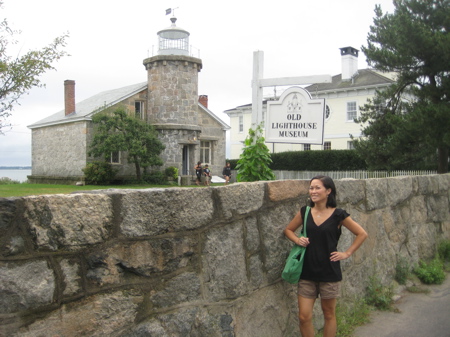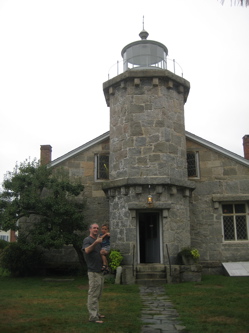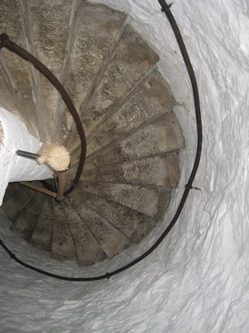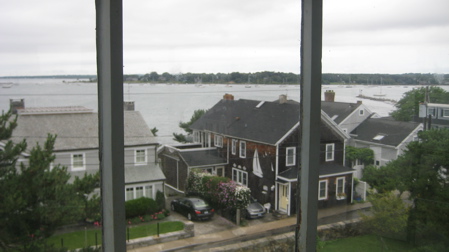Stonington Harbor Lighthouse
30 feet high, at sea level, Stonington
September 3, 2010
*As with many of the lighthouse pages, I’m going to cut and paste information from Lighthouse Friends , below my own accounting.
This lighthouse is open with your Old Lighthouse Museum admission and requires no water passage or special permission. Alas, it’s not exactly tall, but you don’t really need tall at sea level with no trees, right?

After viewing the Old Lighthouse Museum, I made my way up the granite spiral staircase leading to the lighthouse tower’s lantern room. It’s a tight spiral to say the least.
And voila! A beautiful (if a little cramped) view of the Borough of Stonington, Water Street and Little Narragansett Bay!
This lighthouse was once the beacon for the many vessels approaching Stonington’s harbor from Long Island Sound. The original 30-foot stone tower, which was built on the Point in 1823, supported a lantern containing ten oil lamps and parabolic reflectors. Its beacon was visible 12 miles at sea.
During the next few years, however, storms and shore erosion took their toll on the exposed site. In 1840 the structure was dismantled and the materials used to build a new tower and keeper’s dwelling on the present site. The light remained active until 1889 when a beacon was installed on the outer end of a new breakwater protecting the harbor entrance.
Indeed.

Description:
The Borough of Stonington in the southeast corner of Connecticut is a beautiful historic village, with a number of well-preserved houses and other structures dating from the fishing and whaling days of the 18th and 19th-century. First settled in the 17th century, the town had one of its most storied events in 1814, when the badly outnumbered and outgunned townspeople managed to repel an attack by five British warships commanded by Commodore Thomas Hardy. The town was a thriving port, dominated by fishing, whaling, and shipbuilding, and the first U.S. ships involved in sealing in the Antarctic were based in Stonington.
Responding to increasing ship traffic, Congress allocated funds in 1822 for a lighthouse at the southernmost point of land in Stonington to mark the harbor entrance. Benjamin Chase won the contract for construction of the station, and the thirty-foot cylindrical stone tower and stone keeper’s dwelling were finished in 1823 at a cost of roughly $3000. Originally, ten whale oil lamps set in thirteen-inch reflectors and arranged in an arc were used to cast a stream of light out to sea. On a clear night, the light was visible for over twelve miles. During the day, the tower was used as a guiding reference point for sailors entering the harbor, in tandem with the highest steeple in town.
The first Stonington Harbor Lighthouse had a short life due to the quick erosion of the beach in front of the tower. By the late 1830s, there was significant danger of the lighthouse being swept into the sea. At first, construction of a protective wall was considered, but it was realized that a wall would only be a temporary solution. In addition, the preventive measure would cost roughly the same amount as a new lighthouse, so plans for a new structure positioned farther up the peninsula were prepared.

Using stones from the old tower, a new one-and-a-half-story keeper’s quarters was built with a 35-foot octagonal tower centered on the front gable end. The 1840 Stonington Harbor Lighthouse represents the diversity in design that characterized lighthouses built before the Civil War. The new station showed a fixed white light produced by eight lamps with sixteen-inch reflectors, shining from sixty-two feet above sea level.
The first keeper of the Stonington Harbor Lighthouse was Captain William Porter, who kept the post from 1823 until his death in the mid-1840s. If a keeper had been married, the custom in those days was to offer the vacant position first to the keeper’s widow. Porter’s wife Patty accepted the appointment, but a few years later an inspector found that she “kept the most filthy house he had ever visited; everything appeared to have been neglected.” Things must have improved somewhat, as widow Porter remained keeper for six more years.
Following the construction of a breakwater at the entrance to Stonington Harbor, a privately built and maintained light and fog signal were installed at the breakwater’s east end. After it became apparent to local mariners that this beacon was much more effective than the government’s lighthouse, the Lighthouse Board submitted the following request in 1888 for funds to place an official light on the breakwater.
In consequence of the completion of the breakwater at the entrance of this harbor, the present light has ceased to be of any practical use as an aid to navigation. For some time past the Stonington and Providence Steam-Boat Company has maintained, at its own expense, a private light and fog-signal on the eastern end of this breakwater. The Board therefore came to the conclusion that a public light and fog-signal should be established here, and it estimated the cost for doing this at $8,000… When this is done the present light will be discontinued.
In 1889, a new 25-foot-tall, conical tower rising from an octagonal base was completed on the breakwater and commenced operation with a fourth-order lens showing a fixed red light. The Stonington Harbor Lighthouse was deactivated at that time, and the keeper was reassigned to care for the breakwater light. The keeper continued to live at the old station’s quarters, although a small shack was built on the breakwater wall, where he stayed when necessary. A frame house was built for the keeper just south of the old Stonington Lighthouse in 1910, and part of this structure is visible still today in the western portion of the yellow house. In 1926, the breakwater light was taken down and replaced with a skeleton tower.
In 1925, the Stonington Harbor Lighthouse was offered for sale by the government. The winning and only bid came from the Stonington Historical Society, who refurbished the structure and opened it to the public as a museum. The Old Lighthouse Museum still operates today, and although it is open seasonally, it is the only lighthouse on the Connecticut mainland that is regularly open to the public. The lighthouse has been well maintained by volunteers over the decades, and now boasts six rooms of diverse exhibits that include nautical tools, items brought from China for trade, early local pottery, and military items relating to the Battle of Stonington during the War of 1812. A fourth-order Fresnel lens is on display upstairs, while in one of the downstairs rooms a section of epoxy flooring allows guests to gaze down into the station’s old cistern and well. Visitors may also climb the granite steps in the tower to be treated to a nice view of the surrounding area. If you look off to the southwest, you can get a distant view of Latimer Reef Lighthouse.

![]()

Leave a Reply